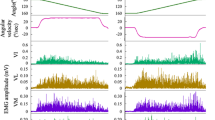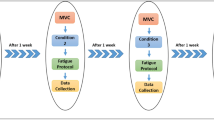Abstract
The purpose of this investigation was to compare the thresholds of neuromuscular fatigue determined simultaneously from the vastus lateralis (VL), vastus medialis (VM) and rectus femoris (RF) muscles using the electromyographic fatigue threshold (EMGFT) test, Eight adult volunteers [mean (SD) age, 33 (10) years] served as subjects for this investigation. The results of a one-way repeated measured ANOVA indicated that there was a significant (P < 0.05) difference among the mean EMGFT values for the VL [248(31)W], VM [223(43)W] and RF [220(30)W] muscles. Tukey post-hoc comparisons indicated that the EMGFT for the RF was significantly (P < 0.05) lower than that of the VL. These findings suggested that during cycle ergometry there is a dissociation in neuromuscular fatigue characteristics of the superficial muscles of the quadriceps femoris group.
Similar content being viewed by others
References
Bigland-Ritchie B, Woods JJ (1974) Integrated EMG and oxygen uptake during dynamic contractions of human muscles. J Appl Physiol 36:475–479
Borg WR, Gall MD (1989) Educational research, 5th ed. Longman, New York, pp 369–370
Cafarelli E (1977) Peripheral and central inputs to the effort sense during cycling exercise. Eur J Appl Physiol 37:181–189
Cohen J, Cohen P (1975) Applied multiple regression/correlation analysis for the behavioral sciences. Lawrence Erlbaum, Hillsdale, pp 125, 265–361
deVries HA (1968) Method for evaluation of muscle fatigue and endurance from electromyographic fatigue curves. Am J Phys Med 47:125–135
deVries HA, Moritani T, Nagata A, Magnussen K (1982) The relation between critical power and neuromuscular fatigue as estimated from electromyographic data. Ergonomics 25:783–791
deVries HA, Tichy MW, Housh TJ, Smyth KD, Tichy AM, Housh DJ (1987) A method for estimating physical working capacity of the fatigue threshold (PWCFT). Ergonomics 30:1195–1204
deVries HA, Housh TJ, Johnson GO, Evans SA, Tharp GD, Housh DJ, Hughes RA (1990) Factors affecting the estimation of physical working capacity at the fatigue threshold. Ergonomics 33:25–33
Edgerton VR, Smith JL, Simpson DR (1975) Muscle fibre type subpopulations of human leg muscles. Histochem 17:259–266
Edwards RG, Lippold OCJ (1956) The relation between the forces and integrated electrical activity in fatigued muscles. J Physiol (Lond) 132:677–681
Helal JN, Guezennec CY, Goubel F (1987) The aerobic-anaerobic transition: re-examination of the threshold concept including an electromyographic approach. Eur J Appl Physiol 56:643–649
Henriksson J, Bonde-Petersen F (1974) Integrated electromyography of quadriceps femoris muscle at different exercise intensities. J Appl Physiol 36:218–220
Johnson MA, Polgar J, Weightman D, Appleton D (1973) Data on the distribution of fibre types in thirty-six human muscles: an autopsy study. J Neurol Sci 18:111–129
Kirk RE (1968) Experimental design: procedures for the behavioral sciences. Brooks and Cole, Belmont, Calif, pp 146–147
Knowlton GC, Bennett RL, McClure R (1951) Electromyography of fatigue. Arch Phys Med 32:648–652
Komi PV, Tesch P (1979) EMG frequency spectrum, muscle structure, and fatigue during dynamic contractions in man. Eur J Appl Physiol 42:41–50
Leger L, Thivierge M (1988) Heart rate monitors: validity, stability, and functionality. Phys Sportsmed 16:143–151
Lippold OCJ, Redfearn JWT, Vuco J (1960) The electromyography of fatigue. Ergonomics 3:121–131
Lynn PA, Bettles ND, Hughes AD, Johnson SW (1978) Influences of electrode geometry on bipolar recordings of the surface electromyogram. Med Biol Eng Comput 16:651–660
Maton B (1981) Human motor unit activity during the onset of muscle fatigue in submaximal isometric and isotonic contractions. Eur J Appl Physiol 46:271–281
Matsumoto T, Ito K, Moritani T (1991) The relationship between anaerobic threshold and electromyographic fatigue threshold in college women. Eur J Appl Physiol 63:1–5
Missiuro W, Kirschner H, Kozlowski S (1962) Electromyographic manifestations of fatigue during work of different intensity. Acta Physiol Pol 13:11–20
Miyashita M, Kanchisa H, Nemoto I (1981) EMG related to anaerobic threshold. J Sports Med 21:209–217
Moritani T, Muro M, Nagata A (1986) Intramuscular and surface electromyogram changes during muscle fatigue. J Appl Physiol 60:1179–1185
Moritani T, Takaishi T, Matsumoto T (1993) Determination of maximal power output at neuromuscular fatigue threshold. J Appl Physiol 74:1729–1734
Nagata A, Muro M, Moritani T, Yoshida T (1981) Anaerobic threshold determination by blood lactate and myoelectric signals. Jpn J Physiol 31:585–597
Nilsson J, Tesch P, Thorstensson A (1977) Fatigue and EMG of repeated fast voluntary contractions in man. Acta Physiol Scand 101:194–198
Pavlat DJ, Housh TJ, Johnson GO, Schmidt RJ, Eckerson JM (1993) An examination of the electromyographic fatigue threshold test. Eur J Appl Physiol 67:305–308
Petrofsky JS (1979) Frequency and amplitude analysis of the EMG during exercise on the bicycle ergometer. Eur J Appl Physiol 41:1–15
Scherrer J, Bourguinon A (1959) Changes in the electromyogram produced by fatigue in man. Am J Phys Med 38:148–158
Takaishi T, Ono T, Yasuda Y (1992) Relationship between muscle fatigue and oxygen uptake during cycle ergometer exercise with different ramp slope increments. Eur J Appl Physiol 65:335–339
Thorstensson A, Karlsson J (1976) Fatiguability and fiber composition of human skeletal muscle. Acta Physiol Scand 98:318–322
Yates F (1933) The analysis of replicated experiments when the field results are incomplete. Emp J Exp Agric 1:129–142
Zipp P (1982) Recommendations for the standardization of lead positions in surface electromyography. Eur J Appl Physiol 50:41–54
Author information
Authors and Affiliations
Rights and permissions
About this article
Cite this article
Housh, T.J., deVries, H.A., Johnson, G.O. et al. Electromyographic fatigue thresholds of the superficial muscles of the quadriceps femoris. Europ. J. Appl. Physiol. 71, 131–136 (1995). https://doi.org/10.1007/BF00854969
Accepted:
Issue Date:
DOI: https://doi.org/10.1007/BF00854969




